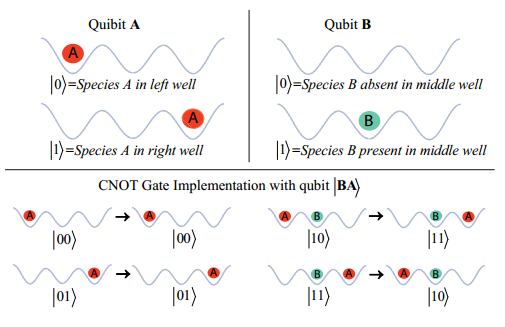How To Build An Atomtronic Logic Gate
Electronics is the manipulation and processing of information using electrons, so it shouldn’t be hard to imagine what the emerging field of atomtronics is attempting to do.

The idea is to manipulate neutral atoms using lasers in a way that mimics the behaviour of electrons in wires, transistors and logic gates.
As a buzzword, atomtronics has been floating around since the mid naughties when it was invented by scientists at the National Institute of Standards and Technology in Boulder, Colorado.
The idea seemed exciting because cold atoms can carry information but also have a range of other exotic properties, such as superfluidity, superconductivity and quantum coherence.
But it’s fair to say the idea has failed to catch the imagination of scientists working with cold atoms and progress has been slow. A (highly scientific) Google search for the word ‘atomtronics’ yields only 21,000 results compared with 760,000 for spintronics and 2,000,000 for electronics.
The biggest problem is the lack of atomtronic devices that can process information–nobody has been able to get these things working. But perhaps that is set to change.
Today, Miroslav Gajdacz at Aarhus University in Denmark and a couple of buddies propose a new way to make a quantum logic gate that could become the building block of a new generation of atomtronic computing devices. What makes their approach noteworthy is that it is simpler than other ideas and so ought to be easier to test.
One of the fundamental properties of a logic gate is the way in which it handles information, perhaps as internal atomic states, nuclear spins or vibrational states.
Gajdacz and co have a different approach. These guys are using position to encode information–to be precise, the relative positions of two different types of atoms that repel each other.
These atoms sit in a potential well that is like an eggbox with three compartments. When the first type of atom (atom A) sits in the left hand well, it encodes a 0; when in the right hand well, it encodes a 1. Atom B can only sit in the central well. When it is present, it encodes a 1; when it is absent, it encodes a 0.
Now a bit of background about logic gates. A CNOT gate has two inputs–a target bit and a control bit. It flips the target bit if and only if the control bit is a 1.
So the new device would work as a CNOT gate if it tossed atom A from the left to the right hand well, and vice versa, if and only if atom B is present.
The trick that Gajdacz and co have perfected is to design a potential well that does exactly this kind of juggling. It works because the presence of both atoms creates a repulsive force that changes the balance of the potential wells, tossing atom A from one side of the device to the other. That’s exactly the behaviour required of a CNOT gate.
It also allows some tweaking so that it is possible to control the rate at which this occurs. That’s important for determining the gate cycle time, which Gajdacz and co estimate at about 1ms.
Of course, if all this were easy, we’d already have atom chips capable of computing in this fashion. But there are significant challenges ahead. Not least of these will be finding a way to accurately read out the results while ensuring that error rates are small.
The acid test will come when somebody makes a working version of an atomtronic logic gate. Then a new set of challenges arise relating to scaling.
Logic gates are only really useful when the output of one becomes the input of another. But perhaps that’s a problem for another day.
In the meantime, a measure of success as useful as any other will continue to be the Google search count.
Ref: arxiv.org/abs/1207.3108 :An Atomtronics Transistor For Quantum Gates
Keep Reading
Most Popular
Large language models can do jaw-dropping things. But nobody knows exactly why.
And that's a problem. Figuring it out is one of the biggest scientific puzzles of our time and a crucial step towards controlling more powerful future models.
The problem with plug-in hybrids? Their drivers.
Plug-in hybrids are often sold as a transition to EVs, but new data from Europe shows we’re still underestimating the emissions they produce.
Google DeepMind’s new generative model makes Super Mario–like games from scratch
Genie learns how to control games by watching hours and hours of video. It could help train next-gen robots too.
How scientists traced a mysterious covid case back to six toilets
When wastewater surveillance turns into a hunt for a single infected individual, the ethics get tricky.
Stay connected
Get the latest updates from
MIT Technology Review
Discover special offers, top stories, upcoming events, and more.